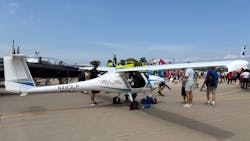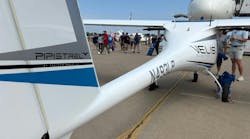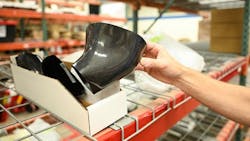Textron eAviation Powers U.S. Flight Schools with Pipistrel’s Electric Aircraft
Key Takeaways
- Pipistrel's Velis Electro is the first fully electric, type-certified aircraft, ideal for flight training with its low noise profile and cost efficiency.
- The Alpha Trainer offers modern avionics, low operational costs, and is a cost-effective solution for flight schools seeking updated training aircraft.
- Electric aircraft maintenance involves fewer moving parts, reducing costs and complexity, with specialized training courses available for technicians.
- The new parts warehouse in Wichita, Kansas, supports Pipistrel's fleet in North America, ensuring quick access to essential components and enhanced customer support.
Pipistrel by Textron eAviation, a subsidiary of Textron Inc., is driving innovation in flight schools with its next-generation aircraft and expanding its customer support network with a new parts warehouse.
During EAA AirVenture 2025, Aviation Pros met with Tricia Steel, vice president, Global Sales & Marketing at Textron eAviation to discuss the company’s latest milestones in electric propulsion and customer support.
“We're thrilled to be at Oshkosh this year. We have a great mix of a lineup with our products,” said Tricia Steel, “We have everything from the Panthera—which we're working through type certification on—our entrance into the high-power single engine space. So, pretty excited to have the Panthera on display.”
“And obviously the Alpha Trainer, the Electro and the Sinus Max. That is positioned as not only an aircraft, but also a motor glider,” Steel added.
How Pipistrel’s next-gen aircraft enhance flight training
Steel provided more detail about the Velis Electro, sharing, “The Velis Electro is the first—and only—type certified fully electric aircraft. The Velis is really special to us because it really showcases the investment in technology and electric propulsion that the company has made and continues to build upon through our other products.”
She continued, “We love the Velis. It is predominantly used for flight training, so think takeoff, landings, patterns, circuit work. It has a very low noise profile—60 DBA, which is incredible—that’s inaudible at 500 feet.”
Steel added, “We really are looking at flight schools who see it as a very economical asset for their schools because it’s fully electric, so, no fuel.”
When asked more about the use of Pipistrel’s next-gen aircraft in flight schools, Steel also highlighted the Alpha Trainer, a two-seat composite aircraft equipped with modern tech.
Steel shared, “It's a great flight training solution for a couple reasons. For one, it’s a very low acquisition cost compared to other traditional trainers.”
Steel continued, “Two, from an operational standpoint, it only consumes 3.6 gallons per hour. That’s 25 percent more efficient than its competitors in the LSA space, 60+ percent more economical than traditional trainers. It also has a modern cockpit. You have the Garmin G3X, which is amazing.”
“We think about pilots and what's exciting them from a flight school perspective. Instead of being in an older asset with older avionics, they're able to walk into something like an Alpha Trainer that’s not only great for the school from an economical perspective, but also great for them from a flight training cost perspective and has modern, updated technology,” said Steel.
How to prepare for maintenance on electrified aircraft
Focusing on the maintenance aspect of electric aircraft, Steel gave insight into what MROs, repair shops and owners could do to prepare for the potential increase in popularity of airplanes like the Velis Electro.
Steel noted, “You have some similar maintenance standards, but the big differentiator is that you have an electric powertrain. So, you have fewer moving parts, which is going to equate to less investment. The other great thing is that the batteries are LRUs. Line Replaceable Units don’t have to have a high voltage requirement on the batteries, which is unique from that maintenance perspective.”
Steel added, “Also, Pipistrel offers a five-day maintenance course specific to the Velis Electro, so really helping those who are adopting that technology as a personal use airplane or into their flight school to become familiar. We handle that for the customer as well.”
“It’s a new frontier, right? I think the great part for us is that we have over 100 Velis Electros out in the field, so the install base is growing, which is really great for electric propulsion. And the adoption into flight schools as a part of standard maintenance is really helping with that learning and, hopefully, people embracing new technology,” concluded Steel.
What to know about Pipistrel’s new parts warehouse
Pipistrel also recently announced the opening of a new parts warehouse in Wichita, Kansas, that will support customers by stocking parts for all Pipistrel aircraft currently in production. This includes the electrified Velis Electro and the Alpha Trainer.
On the significance of the aftermarket parts warehouse, Steel said, “This is really a testament to our commitment to building our aftermarket and really supporting the fleet in North America. This is great for us and really builds on us, adding field service support in the U.S. over the last year to make sure that our customers, from a global perspective, all feel important.”
“As a Textron company, it's incredibly important to us that our customers feel supported and taken care of, building on a long history of putting our customers first and creating loyalty in our brand. Under Textron eAviation, we're doing exactly the same thing,” added Steel.






